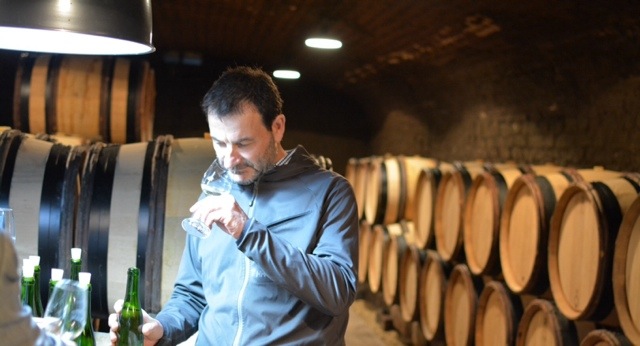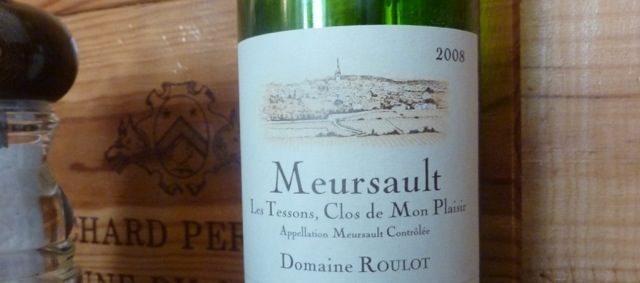Vinmøte Jon 27.10.16
Puligny Montrachet 2004 Lequin Colin viste årgangens storhet i hvit burgund. Vinen var jo relativ rimelig da den ble lansert på Vinmonopolet (kr. 270,-) og den holder seg fremdeles frisk og vital. Strågul mot gylden farge fremdeles med en liten grønn kant. Moden og fremoverlent frukt, en anelse herbal og typisk 04 mineralsk. Noen gjettet Meursault pga. den modne frukten. Kan fremdeles ligge. 91 poeng
Fra Dn.no:
François Lequin-Colin overtok familiegården for i 2005, og ikke alle årganger har vært like spennende. Men med 2013-årgangen tar han konkurransen opp med de virkelig store i Burgund. Hovedforskjellen er at Lequin-Colins viner er tilgjengelige til en gunstigere pris. Lequin-Colins hvitviner fra 2013 har akkurat det du ønsker i en hvit burgunder, og litt til: Konsentrert, med en moden og sammensatt, typeriktig mineralsk frukt, pent integrert eikepreg og spenstig syre. Familien har gjort seg bemerket som den kanskje beste produsenten i Santenay, sør i Burgund. Suksessen ble skapt av François’ foreldre. René Lequins giftet seg med Josette Colin, som kom fra en annen vinmakerfamilie fra nabolandsbyen Chassagne-Montrachet. Sammen bygget de opp en liten og familiedrevet vingård på nittitallet. Totalt eier familien Lequin-Colin i dag ni hektar vinmark, hvorav mesteparten befinner seg i Santenay og Chassagne-Montrachet, mens det resterende befinner seg i Saint-Aubin, Nuits-Saint-Georges og Pommard. Rosinen i pølsen er 0,12 hektar med Bâtard-Montrachet, 0,09 hektar med Corton les Languettes og 0,09 hektar med Corton Charlemagne.
Meursault Les Tessons Clos de Mon Plaisir 2006 Domaine Roulot
Hvis den forrige vinen var litt "meursaulsk" var denne litt "pulignyish" ! Klar og ren i en typisk grønn og dyp konsentrert Roulot stil. Noe strågul , god mineralitet med et snev av utvikling. Flint og vinen balanserer godt. Presis og elegant, selv med et touch av alkohol. Viser at igjen at 2006 er en god hvit burgundårgang. 92 poeng.

Fra winehog:
Single vineyard village wines are becoming more and more popular in Burgundy, as the focus on terroir and the quality of the different climates increases.
Meursault is one of the appellations where the tradition with single vineyard village is becoming more deeply rooted in the Burgundian soil.
Producers like Coche-Dury and Domaine Roulot have a quite large selection of village wines, and others like Jean-Philippe Fichet, Arnaud Ente and Michel Bouzereau also have more village bottlings.
This eventually leads to the question … what are the best and most prominent village terroirs in Meursault.
Historic view on the Meursault village terroirs
As always one can turn to the historic sources, to see how the vineyards were regarded in the good old days!
For appellations like Meursault this will however only yield part of the answer, as some vineyards were producing reds if we go 100 years back, and other vineyards especially at the top of the slope were not fully developed and thus not a part of the classification in the 1850s and 1860s.
Lastly the climate change seem to have elevated the quality of some of the vineyards high on the slope, and in my view the old classifications are therefore somewhat biased towards the terroirs located in the bottom of the slope.
So the full answer will not be found in the historic sources … but I think there is some important knowledge to be found.
The Lavalle classification in 1855
The Lavalle1 strongpoint is the classification of the northern appellations, the white appellations are not that well covered by Lavalle, and the classification seems a bit more erratic. That being said Lavalle has done a tremendous job in his book, as one of the first covering this in detail.
Lavalle has Les Perriéres both Dessus and Dessous as Tète de Cuvée and among the Premiére Cuvées we find one current village vineyard – Les Tessons (5.2930 ha) alongside the upper parts of Genevriéres and Charmes, La Goutte-D’Or and Les Bouchéres1
Moving on to the Deuxiéme Cuvées we find Le Rougeot (3.1740 ha) and Les Grands Charrons (15,054 ha), Les Chevaliéres (10,3870 ha) alongside Le Porusot-Dessus and Le Porusot1.
Interestingly the lower part of Genevriéres and Charmes are not mentioned by Lavalle in his classification.
The 1862 classification
Moving on to the 1862 classification2 we find a more detailed picture of Meursault. In this article I will focus only on the terroirs producing whites in 1862.
Among the 1re Classe we now find the Blagny side 1er crus La Piéce sous-le-Bois, La Jeunelotte, Sous-Blagny, Sous-le-Dos d’Ane and Le Dos-d’Ane all located in the Blagny section of Meursault2. These were not mentioned by Lavalle, as the Blagny “area” were somewhat overlooked by Lavalle – at least in the versions I have.
Moving on to 2e Classe we find the following village terroirs Les Petits-Charrons, Les Chevaliéres, Les Rougeots, Le Tesson, Les Grands-Charrons2.
Parts of La Barre-Dessus, Les Perchots (below La Barre Dessus), and Le Lemosin (below Genevriéres) were also classified as 2e Classe in the very detailed 1862 classifcation2.
The classification can be seen on the map below2, with all the 2e Classe vineyards marked yellow. Please note this is a mixed classification showing both red and whites, and while a terroir is good for reds, it’s not necessarily as good for whites … and vice versa.
 Map from Batault-Morot, E. Plan statistique des vignobles produisant les grands vins de Bourgogne. (1861) – click to enlarge map
Map from Batault-Morot, E. Plan statistique des vignobles produisant les grands vins de Bourgogne. (1861) – click to enlarge map
The Rodier classification from 1920
Rodier3 mentioned the village terroirs Les Rougeots, Les Grands-Charrons, Les Petits-Charrons, Les Chevaliéres, Le Tesson as Deuxiémes Cuvées in his classification from 1920.
It should be noted that terroirs like Cromin and Les Meix Chaveaux were producing reds when Rodier made his classification, so things have changed somewhat over the last 80 years.
The best village terroirs – according to the old classifications
The tree classifications above show a quite similar pattern with only Le Tesson edging a bit in front of the others in the Lavalle classification. But that aside there seem to be consensus about the following vineyard as the best village terroirs in Meursault:
- Le Tesson
- Le Rougeot
- Les Chevaliéres
- Les Grands–Charrons
- Les Petits-Charrons
These vineyards are all located north of the classic 1er crus of Meursault, and just above the village – see map below.
 Click to enlarge map
Click to enlarge map
The five vinyards are located at almost the same altitude as the 1er crus south of the village, and presumably with the best vineyards at the top, just as with the 1er crus. The map below show the five village terroirs in detail.
 Click to enlarge map
Click to enlarge map
Meursault Le Tesson – 1er cru? or close to 1er cru
Le Tesson is according to the old classifications among the best or if not the best of the current Meursault village climates.
The Tesson vineyard is located above the village of Meursault, at approximately the same altitude as the lower part of Perrieres, and above Les Grand-Charrons – see map above.
Domaine Roulot makes the most prominent Le Tesson – the cuvee Les Tesson Clos de Mon Plaisir, and this is normally the best of Roulots large selection of village Meursaults. It seems to combine the minerality of the higher located village wines like Luchets and Tillets with a 1er cru like weight and persistence, thus elevating the wine to a good 1er cru level.
 Click to enlarge map
Click to enlarge map
I’m not suggesting that it’s a big 1er cru, as it in my view can’t challenge Boucheres and Perrirers from Roulot on any level, but it have the qualities that can rival even very good wines from Gouttes d’Or or the lesser parts of Meursault Charmes.
Crystallum Clay Shales Chardonnay 2015, Sør Afrika
Grønn, transparent med spisskumin, Litt mmye alkohol, uharmonisk , tropisk og fet. Samtidig litt riesling og Sauvignon Blanc ! Vi var på oversjøisk, men ikke på Chardonnay ! 82 poeng.
Chablis Les Forets 1995, Vincent Dauvissat
Botrytis, eldre vin. Chablis ? På grensen til det oksidative. Dvask, tørr og utviklet. Men bra syre. Jon har servert denne flere ganger og de fleste er gone. Denne var noe bedre. 87 poeng























